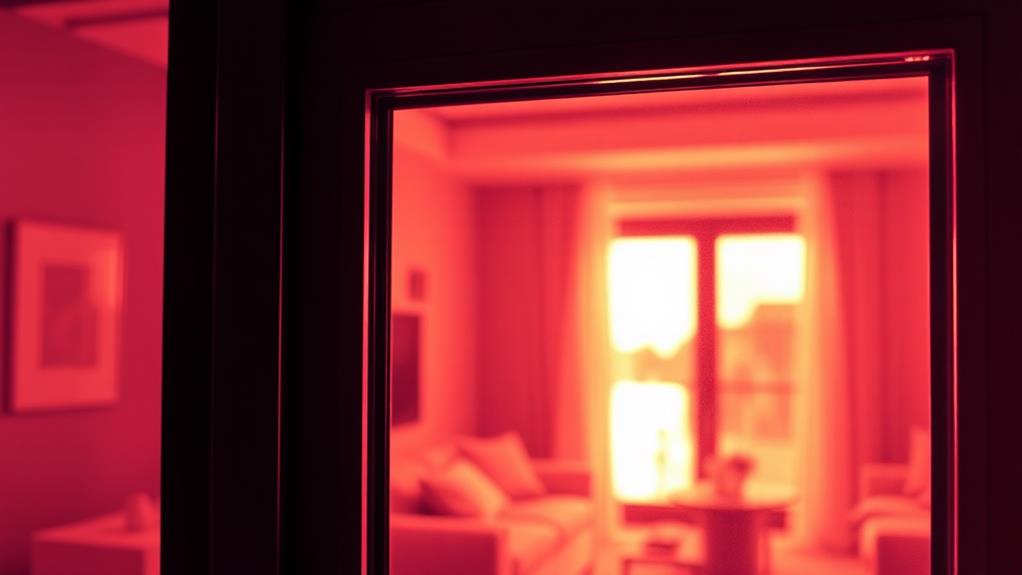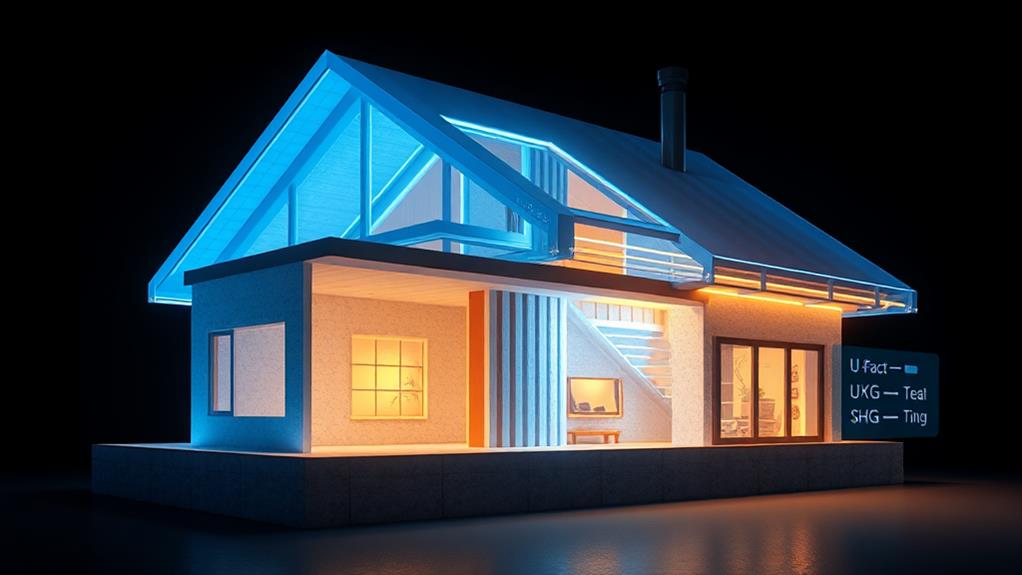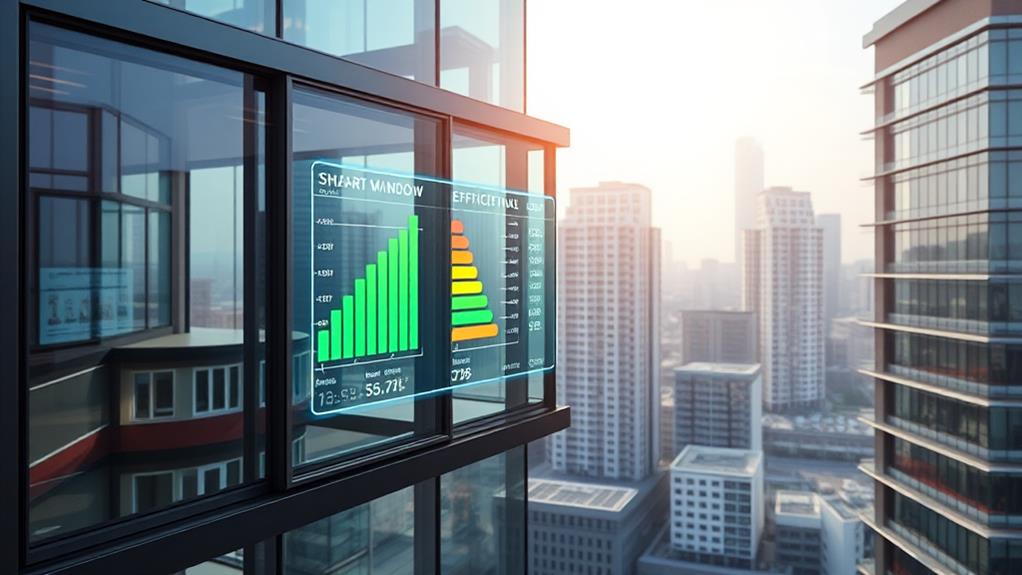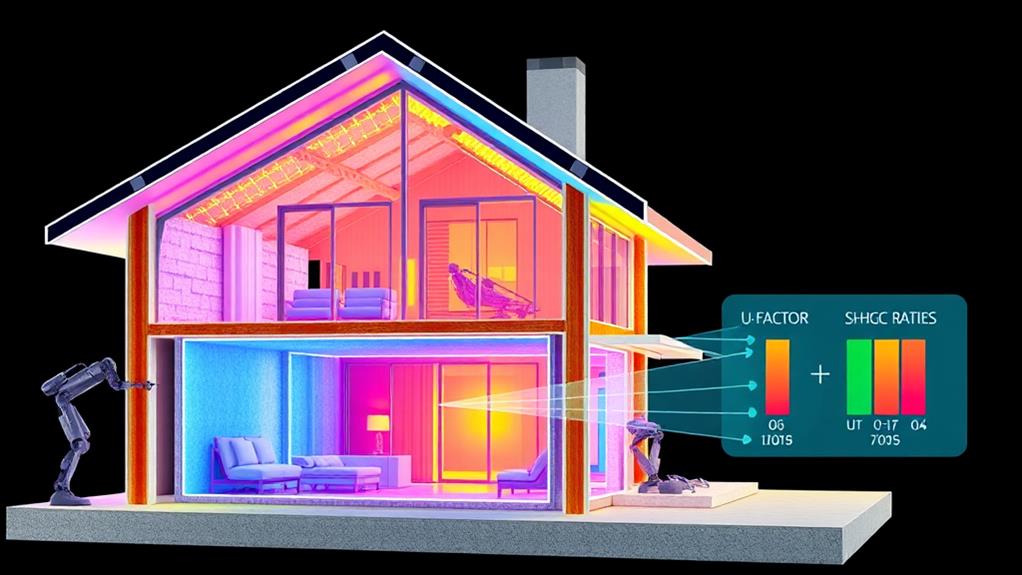When selecting energy-efficient windows, you'll need to understand U-factor and SHGC ratings. U-factor measures insulation effectiveness, with lower values indicating better performance. SHGC determines solar heat gain, which you'll want to optimize based on your climate. Look for windows with a U-factor of 0.30 or less and an appropriate SHGC for your region. Future innovations include photovoltaic windows, smart tinting technology, and vacuum-insulated panes. These advancements, combined with proper insulation, will significantly improve your home's energy efficiency and comfort. By mastering these concepts, you'll be well-equipped to make informed decisions for your home's future.
Decoding U-Factor Ratings

Windows' energy efficiency is often measured by their U-factor rating, a crucial metric for homeowners looking to improve their property's insulation. The U-factor quantifies how well a window prevents heat from escaping, with lower values indicating better insulation. When you're shopping for new windows, you'll typically see U-factor ratings ranging from 0.20 to 1.20.
To decode these ratings, remember that the lower the U-factor, the more energy-efficient the window. For example, a window with a U-factor of 0.30 will retain heat better than one with a 0.50 rating. Climate plays a significant role in determining the ideal U-factor for your home. If you live in a colder region, you'll want windows with a lower U-factor to minimize heat loss during winter months.
It's important to note that U-factor ratings apply to the entire window assembly, including the frame and spacers, not just the glass. This comprehensive measurement gives you a more accurate picture of the window's overall insulating performance. When comparing windows, always look for the National Fenestration Rating Council (NFRC) label, which provides standardized U-factor ratings for easy comparison across different manufacturers and products.
SHGC Ratings Explained
Alongside U-factor ratings, SHGC (Solar Heat Gain Coefficient) is another crucial metric for evaluating window energy efficiency. SHGC measures how much solar radiation passes through a window, expressed as a number between 0 and 1. A lower SHGC means less solar heat gain, which is generally desirable in warm climates to reduce cooling costs.
When selecting windows, you'll want to consider your local climate and the window's orientation. In cooler regions, a higher SHGC might be beneficial for south-facing windows to capture more solar heat in winter. However, in hot climates, you'll typically want a lower SHGC to minimize heat gain and reduce air conditioning loads.
Modern low-E coatings can help you achieve a balance between visible light transmission and solar heat gain. These coatings can be customized to allow specific wavelengths of light to pass through while blocking others. This technology enables you to optimize your windows' performance based on your specific needs and location. By understanding SHGC ratings, you can make informed decisions about window selection, potentially leading to significant energy savings and improved comfort in your home.
Impact on Energy Efficiency

As we delve into the impact on energy efficiency, it's crucial to understand how advanced insulation and window technologies can dramatically reduce your home's energy consumption. By choosing windows with optimal U-factor and SHGC ratings, you'll minimize heat transfer and solar heat gain, leading to significant energy savings.
Low U-factor windows prevent heat loss in winter, reducing your heating costs. In summer, they keep cool air inside, easing the burden on your air conditioning system. Windows with appropriate SHGC ratings for your climate help manage solar heat gain, further enhancing your home's energy performance.
When combined with cutting-edge insulation materials, these energy-efficient windows create a formidable barrier against temperature fluctuations. You'll notice more consistent indoor temperatures and lower utility bills year-round. Advanced insulation technologies, such as aerogels and vacuum insulated panels, offer superior thermal resistance in thinner profiles, maximizing living space while minimizing energy loss.
Choosing the Right Windows
With energy efficiency in mind, selecting the right windows for your home becomes a key factor in maximizing your investment. You'll want to focus on two crucial ratings: U-factor and Solar Heat Gain Coefficient (SHGC). The U-factor measures how well a window insulates, with lower values indicating better performance. For most climates, aim for a U-factor of 0.30 or less.
SHGC measures how much solar heat a window lets in, ranging from 0 to 1. In warm climates, choose a lower SHGC to reduce cooling costs, while in colder regions, a higher SHGC can help with passive solar heating. Consider your local climate and home's orientation when making this decision.
Don't overlook frame materials. Vinyl, fiberglass, and wood offer excellent insulation properties, while aluminum frames conduct heat more readily. Double or triple-pane windows filled with argon or krypton gas provide superior insulation compared to single-pane options.
Lastly, look for ENERGY STAR certified windows, which meet strict energy efficiency guidelines. By carefully considering these factors, you'll choose windows that enhance your home's comfort and energy performance for years to come.
Future Innovations in Window Technology

The future of window technology is brimming with exciting innovations that promise to revolutionize energy efficiency and comfort in our homes. You'll soon see windows with integrated solar cells that generate electricity while maintaining transparency. These photovoltaic windows will help power your home and reduce your reliance on the grid.
Smart windows are another game-changer. You'll be able to control the tint of your windows electronically, adjusting light transmission and heat gain with the touch of a button or through your smartphone. This technology will optimize your home's energy performance throughout the day and seasons.
Vacuum-insulated windows are set to take thermal efficiency to new heights. By removing the air between panes, these windows will drastically reduce heat transfer, surpassing the insulation capabilities of current triple-pane options.
Lastly, keep an eye out for self-cleaning windows. Using advanced nanotechnology coatings, these windows will break down dirt and grime when exposed to sunlight, keeping your views crystal clear with minimal maintenance. These innovations will transform your windows from simple barriers to active contributors to your home's energy efficiency and comfort.
Conclusion
You've now got the knowledge to make informed decisions about energy-efficient windows. By understanding U-factor and SHGC ratings, you'll be able to choose windows that maximize your home's comfort and energy savings. Remember, upgrading to high-performance windows can reduce your energy bills by up to 15%. As window technology continues to advance, you'll have even more options to create a sustainable, comfortable living space. Keep an eye on emerging innovations to stay ahead of the curve.

